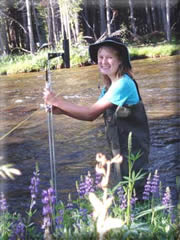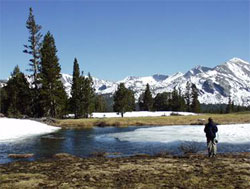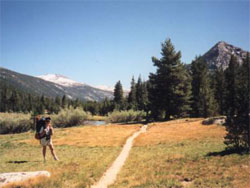Does Snowmelt Vary with Elevation and Angle of the Sun?
|
11.02.04 -- Snowpack has historically been used as a key "reservoir" for drinking water, especially in California, making the study of changes in snowmelt processes a hot topic for environmental researchers. Included in this group is Jessica Lundquist, a Calit² graduate fellow who has been funded for the last three years to study variations in snowmelt and how they are affected by factors such as elevation and what she calls "aspect," the relationship of a snow-covered mountain hill slope to the angle of the sun.
As part of her PhD thesis research at the Scripps Institution of Oceanography, working under Dan Cayan, Lundquist studied and compared snowmelts in Yosemite National Park for 2002-2004.
For 2002, she collected data from instruments at varying elevations and from basins with different aspects. "All stream records were very similar," she says. "The snow melted at the same time everywhere regardless of elevation. That was a surprise to us."
Nearly all "snow pillows," devices that weigh the snow on top of them to determine the snow's water content, recorded that the melt started around the same day as the river started running. This phenomenon was due to a large-scale weather pattern that warmed the area by more than 10 degrees Celsius in fewer than five days.
The year 2003 was a "stranger year." Snowstorms occurred throughout April, due to an abnormal low-pressure system, leading to the melt starting in May. Even so, as in the previous year, almost all streams started running at the same time.
"The one exception was from a station at 11,000 feet draining a tiny north-facing slope," says Lundquist. "Lower-elevation stations all indicated snowmelt happened at the same time." Given that most snow pillows are at 10,000 feet or below, this data suggested the importance of instrumenting at higher elevations.
|
Data from 2004, however, led Lundquist in theopposite direction: Elevation and aspect did make a difference in the timing of onset of streamflow. "
Frankly, these are the results we had expected for the other two years," says Lundquist. "Our monitoring system, though, is so new that it's hard to know what's typical. We're continuing to look at what accounts for the differences between 2002/2003 and 2004."
Preliminary analysis suggests that the biggest differences were caused because the 2004 warming was so early. The angle of the sun in the sky changes dramatically between March 1 and April 1, resulting in a rapid increase in the number of hours of daylight during this period. The abnormally early 2004 onset came before the spring equinox, when the sun was still low in the sky, and shading from steep mountain peaks at higher elevations kept many rivers out of the sun, delaying the onset of melt in spite of the warm temperatures. This data suggests that, in a warmer climate with earlier spring melts, local topography and shading may become more important factors in creating accurate snowmelt forecasts.
Interestingly, in 2004, a network of predominantly low-elevation gauges monitored by the U.S. Geological Survey recorded one of the earliest onsets of spring on record the second week of March which accords with work by Cayan and Michael Dettinger indicating that the spring runoff has come earlier during the last two or three decades as temperatures over western North America have warmed. (See a special article on the 2004 onset in EOS: Vol. 85, No. 40, 5 October 2004.)
Calit² support has helped this project "go wireless" in that it gave Cayan the latitude to reprogram grant funding targeted for Lundquist's support to instead purchase more instrumentation. Says Lundquist, "The stream gauge in the Tuolumne River under Tioga Road at 9,000 feet, for example, includes an antenna that beams data to a snow pillow station that, in turn, transfers the data by satellite to Sacramento, where it can be accessed from the Internet. This allows us to monitor the data every day, rather than manually once a year." Lundquist is hopeful that, the more real-time data they can make available, the more it will become possible to do actual forecasting. And, with this in mind, Cayan is extending the infrastructure to include the Devil's Postpile National Monument at 7,000 feet.
One of the things that motivates Lundquist is the potential for applying her research results to reservoir management: As the climate warms, more precipitation will fall as rain, rather than snow. This rain will rush into the reservoirs at a time when water is a hazard -- rather than a resource -- with the potential to cause flooding. "It's important to store as much water as possible of course, but there's also the danger of a flood wave overtopping the reservoir, which can cause a secondary set of problems."
With her degree in hand, Lundquist has taken a two-year joint position with the University of Colorado at Boulder and the NOAA Climate Diagnostic Center and Environmental Technology Lab. Besides continuing to analyze the 2004 data, she expects to apply her methodology to snowpack/snowmelt in the Rocky Mountains, which suffer from the same water resource problems as Yosemite.
She'll also be joining a new program studying storms affecting the American River basin, the mountainous watershed to the east of Sacramento. This is an area extremely prone to flooding. It spans a lot of lower elevations and is very sensitive to whether precipitation falls as rain or snow. "The reflectance of radar bounces differently off snow versus rain," says Lundquist, "which enables you to estimate at what elevation you're getting snow vs. rain."
Lundquist also extends her research into public service by writing about it for her fellow environmental enthusiasts. See, for example, her article in Sierra Nature Notes (Vol. 4, June 2004; http://www.yosemite.org/naturenotes/) "When is the best time to cross a mountain stream? Understanding daily variations in streamflow," which describes diurnal cycles in streamflow and how they change with the scale of the basin.
For more on Lundquist’s work, see http://tenaya.ucsd.edu/~jessica/.




